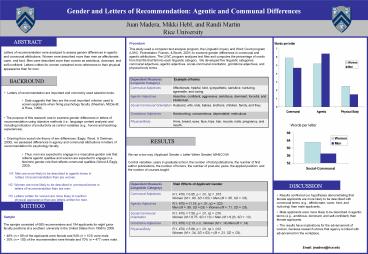Gender and Letters of Recommendation: Agentic and Communal Differences - PowerPoint PPT Presentation
Title:
Gender and Letters of Recommendation: Agentic and Communal Differences
Description:
Gender and Letters of Recommendation: Agentic and Communal Differences Juan Madera, Mikki Hebl, and Randi Martin Rice University ABSTRACT Procedure – PowerPoint PPT presentation
Number of Views:120
Avg rating:3.0/5.0
Title: Gender and Letters of Recommendation: Agentic and Communal Differences
1
Gender and Letters of Recommendation Agentic and
Communal Differences
Juan Madera, Mikki Hebl, and Randi MartinRice
University
ABSTRACT
Procedure This study used a computer text
analysis program, the Linguistic Inquiry and Word
Count program (LIWC Pennebaker, Francis,
Booth, 2001) to examine gender differences in
communal and agentic attributions. The LIWC
program analyzes text files and computes the
percentage of words from that file that fall into
each linguistic category. We developed five
linguistic categories communal adjectives,
agentic adjectives, social-communal orientation,
grindstone adjectives, and physical body terms.
Letters of recommendation were analyzed to assess
gender differences in agentic and communal
attributions. Women were described more than men
as affectionate, warm, and kind. Men were
described more than women as ambitious, dominant,
and self-confident. Letters written for women
contained more references to their physical
appearance than for men.
Dependent Measures (Linguistic Category) Example of terms
Communal Adjectives Affectionate, helpful, kind, sympathetic, sensitive, nurturing, agreeable, and caring.
Agentic Adjectives Assertive, confident, aggressive, ambitious, dominant, forceful, and intellectual.
Social-Communal Orientation Husband, wife, kids, babies, brothers, children, family, and they.
Grindstone Adjectives Hardworking, conscientious, dependable, meticulous
Physical-Body Arms, breast, eyes, face, hips, hair, muscle, nails, pregnancy, and mouth.
BACKROUND
- Letters of recommendation are important and
commonly used selection tools. - Data suggests that they are the most important
criterion used to screen applicants when hiring
psychology faculty (Sheehan, McDevitt, Ross,
1998). - The purpose of this research was to examine
gender differences in letters of recommendation
using objective methods (i.e., language content
analysis) and including indicators of
productivity as control variables (e.g., honors
and teaching experiences). - Drawing from social role theory of sex
differences (Eagly, Wood, Diekman, 2000), we
assessed differences in agency and communal
attributions in letters of recommendation for
psychology faculty. - Thus, men are expected to engage in a masculine
gender role that reflects agentic qualities and
women are expected to engage in a feminine gender
role that reflects communal qualities (Wood
Eagly, 2002). - H1 Men are more likely to be described in
agentic terms in - letters of recommendation than are
women. - H2. Women are more likely to be described in
communal terms in - letters of recommendation than are
men. - H3. Letters written for women are more
likely to mention - physical appearance than are letters
written for men.
RESULTS
We ran a two-way (Applicant Gender x Letter
Writer Gender) MANCOVA Control variables
years in graduate school, the number of total
publications, the number of first author
publications, the number of honors, the number of
post-doc years, the applied position, and the
number of courses taught.
Dependent Measures (Linguistic Category) Main Effects of Applicant Gender
Communal Adjectives F(1, 470) 6.95, p lt .01, ?2 .015 Women (M .80, SD .03) gt Men (M .65, SD .03).
Agentic Adjectives F(1, 470) 11.19, p lt .01, ?2 .023 Men (M .89, SD .03) gt Women (M .71, SD .03).
Social-Communal Orientation F(1, 470) 7.58, p lt .01, ?2 .016 Women (M 8.75, SD .13) gt Men (M 8.23, SD .13).
Grindstone Adjectives F(1, 470) 2.13, n.s. Women (M .14) Men (M .14)
Physical-Body F(1, 470) 5.89, p lt .01, ?2 .012 Women (M .34, SD .03) gt (M .21, SD .03).
DISCUSSION
- Results confirmed our hypotheses demonstrating
that female applicants are more likely to be
described with communal terms (e.g.,
affectionate, warm, kind, and nurturing) than
male applicants. - Male applicants were more likely to be
described in agentic terms (e.g., ambitious,
dominant, and self-confident) than female
applicants. - The results have implications for the
advancement of women, because research shows that
agency is linked with advancement in the
workplace.
METHOD
- Sample
- The sample consisted of 685 recommenders and 194
applicants for eight junior faculty positions at
a southern university in the United States from
1998 to 2006. - 46 (n 89) of the applicants were female and
54 (n 103) were male - 30 (n 193) of the recommenders were female
and 70 (n 477) were male.
Email jmadera_at_rice.edu































